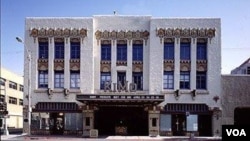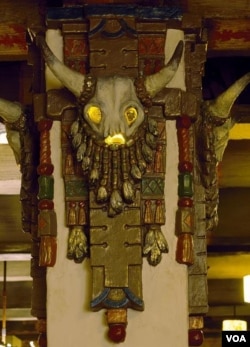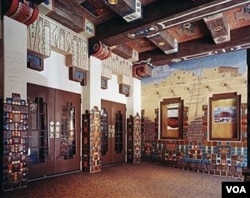In many American cities, one can find beautifully restored movie houses from the Golden Age of Motion Pictures in the 1920s and ’30s.
Many boast classical décor, complete with crystal chandeliers, velvet draperies, statues and urns, and gilt-leaf molding.
There’s an elegantly restored theater in Albuquerque, New Mexico, but it has quite a different look.
So unusual that throughout New Mexico you can find people who share a stark memory of being scared out of their skulls there - and not by the movie that was showing.
In the early 1900s, a local businessman named Oreste Bachechi was making a fortune selling liquor, some of it to the movie stars whose cross-country trains stopped to refuel outside of Albuquerque.
He fell in love with films and decided to build the city’s first movie palace.
And he wanted something different - something that would reflect the unique influence of New Mexico’s native American culture.
So he built a movie house filled with Indian rugs, light fixtures shaped like war drums, and walls decorated with thunderbirds and backward swastikas - American Indian symbols of happiness, life, and freedom.
But here’s what would later scare his young patrons in particular: He lined the walls with steer skulls, whose empty eye sockets glowed a spooky amber when the auditorium lights went down.
Bachechi called his theater the “KiMo,” which in the Tiwa Indian tongue broadly describes anything that is “king of its kind.”
Like many U.S. movie palaces, the KiMo’s financial fortunes declined with the coming of television.
Its owners even resorted to showing pornographic films for awhile.
But the theater closed in 1968 and remained shuttered for 15 years until a fundraising drive led to its glorious restoration.
Today, the KiMo screens classic movies and offers its stage to regional theatre and musical groups.
And the steer skulls glow eerily once again.
Many boast classical décor, complete with crystal chandeliers, velvet draperies, statues and urns, and gilt-leaf molding.
There’s an elegantly restored theater in Albuquerque, New Mexico, but it has quite a different look.
So unusual that throughout New Mexico you can find people who share a stark memory of being scared out of their skulls there - and not by the movie that was showing.
In the early 1900s, a local businessman named Oreste Bachechi was making a fortune selling liquor, some of it to the movie stars whose cross-country trains stopped to refuel outside of Albuquerque.
He fell in love with films and decided to build the city’s first movie palace.
And he wanted something different - something that would reflect the unique influence of New Mexico’s native American culture.
So he built a movie house filled with Indian rugs, light fixtures shaped like war drums, and walls decorated with thunderbirds and backward swastikas - American Indian symbols of happiness, life, and freedom.
But here’s what would later scare his young patrons in particular: He lined the walls with steer skulls, whose empty eye sockets glowed a spooky amber when the auditorium lights went down.
Bachechi called his theater the “KiMo,” which in the Tiwa Indian tongue broadly describes anything that is “king of its kind.”
Like many U.S. movie palaces, the KiMo’s financial fortunes declined with the coming of television.
Its owners even resorted to showing pornographic films for awhile.
But the theater closed in 1968 and remained shuttered for 15 years until a fundraising drive led to its glorious restoration.
Today, the KiMo screens classic movies and offers its stage to regional theatre and musical groups.
And the steer skulls glow eerily once again.










